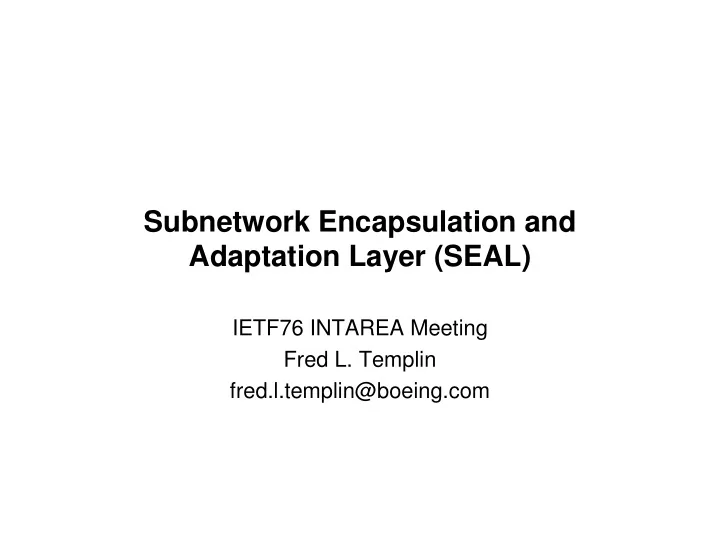

Subnetwork Encapsulation and Adaptation Layer (SEAL) IETF76 INTAREA Meeting Fred L. Templin fred.l.templin@boeing.com
Tunnel Maximum Transmission Unit (MTU) End-to-End Final Destination Marginal Link Tunnel (MTU=1500) MTU=1500 MTU=1KB Original Source MTU=9KB (MTU=9KB) Low-end Egress Site B Tunnel MTU=9KB Endpoint MTU=4KB Ingress MTU=2KB High-end Tunnel Site A Endpoint MTU=?? Subnetwork
SEAL Approach • Used with IP-in-IP encapsulation • 4Byte encapsulation sublayer • Each packet has a 32bit sequence number • Track MTU w/o classical path MTU discovery • Detect and tune out in-the-network IPv4 fragmentation • Segmentation to mitigate misconfigured MTUs and marginal links • Promotes desired end-state of MTU-robust Internet • Works just like IPv6 fragmentation, except: – fixed segment size – non-overlapping segments – ETE informs ITE of Maximum Receive Unit (MRU) – no prior negotiations between ITE and ETE needed
Draft Status • Significant improvements based on list review input • Standards-track submission through INTAREA • Two distinct “modes” of operation: – SEAL-FS (SEAL with Fragmentation Sensing) • used when all links in the network have MTU of at least M (e.g., 1500) • ETE senses IPv4 fragmentation; sends report to ITE – SEAL-SR (SEAL with Segmentation and Reassembly) • used when end systems need to see an assured MTU of at least M • used when end systems prefer a larger MTU • ETE senses IPv4 fragmentation; sends report to ITE • ITE segments large packets; ETE reassembles
SEAL With Fragmentation Sensing (SEAL-FS) • Minimal mechanism for discovering tunnel MTU • Egress Tunnel Endpoint (ETE): – Informs ITE of MRU without need for pre-negotiations – listens for IP fragmentation and drops all IP fragments – sends “Fragmentation Reports” to Ingress Tunnel Endpoint (ITE) • ITE adjusts tunnel MTU based on fragmentation reports • ITE never has to segment and ETE never has to reassemble • Use cases: – performance-intensive core routers that support many tunnels over paths containing robust links (MTU >> 1500)
SEAL With Segmentation and Reassembly (SEAL-SR) • Same as SEAL-FS, but also includes segmentation and reassembly at a layer below IP • MTU based on maximum size the ETE can reassemble ; NOT on the link with the smallest MTU in the path • End systems see a solid minimum MTU (e.g., 1500), and can often send packets that are larger than the actual path MTU • Supports IPv6 jumbograms even if not all links in the path support jumbograms • Treats reassembly timeouts as indication to reduce MTU • Use cases: – Enterprise routers connecting high-performance data centers – CPE routers – MANET routers
Observations � “Unmitigated Fragmentation Considered Harmful” � “Carefully-managed Fragmentation Considered Useful” � In-the-network fragmentation as “canary in the coal mine” For more information: http://tools.ietf.org/html/draft-templin-intarea-seal (specification) http://osprey67.com/seal (linux source code)
BACKUPS
Problems with Classical Path MTU Discovery • ICMPs may be lost, erroneous, fabricated • ICMPs may have insufficient information for relaying • ALWAYS drops packets when MTU insufficient • In-the-network tunnels may have 1000’s of packets in-flight when a routing change hits an MTU restriction: – all packets are dropped – flood of ICMPs returned to ITR – resources wasted
MTU Configuration Knob 1280 …. 2048 • < 1280: MinMTU underflow • < 1400: fragmentation unlikely • < 2048: fragmentation managed • 2048 – 64KB: best-effort • > 64KB: jumbogram
SEAL Encapsulation • Extends IP-ID to 32 bits Payload • Report Fragmentation mechanism • Tunnel segmentation and reassembly • Nonce-protected error feedback Inner Headers (IP, IP/ESP, etc.) • Compatible with wide variety of tunnels SEAL Header (4 Bytes) Outer Headers 0 1 2 3 (IP, UDP/IP, etc.) 0 1 2 3 4 5 6 7 8 9 0 1 2 3 4 5 6 7 8 9 0 1 2 3 4 5 6 7 8 9 0 1 +-+-+-+-+-+-+-+-+-+-+-+-+-+-+-+-+-+-+-+-+-+-+-+-+-+-+-+-+-+-+-+-+ | ID Extension |A|R|M|RSV| SEG | Next Header | +-+-+-+-+-+-+-+-+-+-+-+-+-+-+-+-+-+-+-+-+-+-+-+-+-+-+-+-+-+-+-+-+ ID Extension (16 bits) A – Acknowledgement Requested (1 bit) R – Report Fragmentation (1 bit) M – More Segments (1 bit) RSV – Reserved (2 bits) SEG – Segment number (3 bits) Next Header (8 bits)
Recommend
More recommend